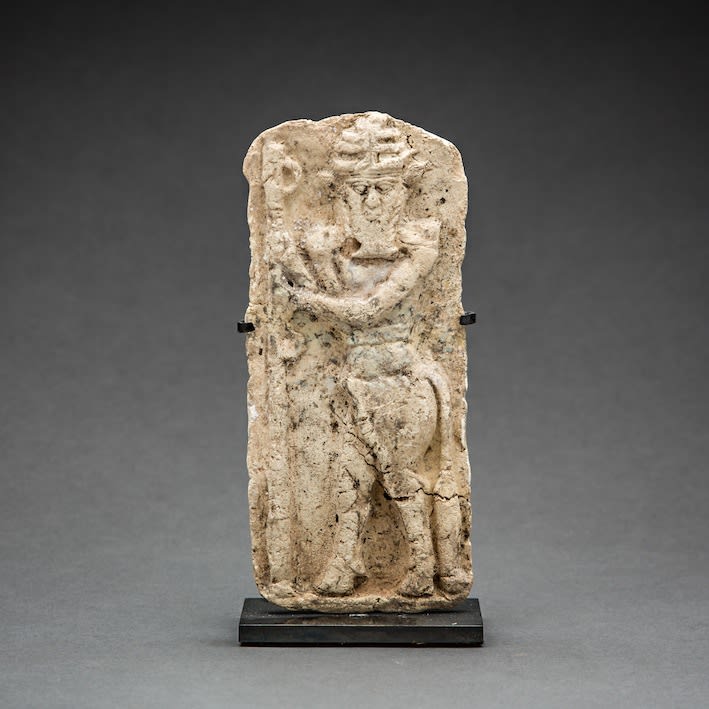Old Babylonian Moulded Plaque with Standing Bull Man, 2000 BCE - 1700 BCE
Terracotta
height 15.2 cm
height 6 in
height 6 in
LO.1163
The Old Babylonian period describes south Mesopotamia between 2000-1600 BC. The early years saw a number of important states dominating the region: Isin, Larsa, Eshnunna and, from 1894 BC, Babylon....
The Old Babylonian period describes south Mesopotamia between 2000-1600 BC. The early years saw a number of important states dominating the region: Isin, Larsa, Eshnunna and, from 1894 BC, Babylon. Babylon was ruled by a dynasty of Amorite kings. The sixth ruler was Hammurapi, who defeated the other southern states and expanded his control into north Mesopotamia. On the death of Hammurapi the empire gradually shrank over about 150 years. Nonetheless, Babylon remained an important power until it was sacked by the Hittite king, Mursili I, in about 1595 BC. During the Old Babylonian period literary activity flourished with scribes composing and recording religious, poetic and 'scientific' works in Sumerian and Akkadian cuneiform. Perhaps the most famous monument is the stele of Hammurapi, now in the Musée du Louvre, Paris.
Ceramic plaques of this sort were mass-produced from moulds and represent a form of art available to a wide audience. The casting of plaques was a simple and inexpensive way to produce relief images, since numerous plaques could be made from a single mold. They have been excavated in temples as well as household shrines in private homes. Their subject matter varies widely, including religious images, mythological and erotic scenes, and representations of rulers and gods.
This plaque depicts a hittyphallic creature with the head and torso of a human but the horns, lower body and legs of a bull. Though similar figures are depicted earlier in Iran, they are first seen in Mesopotamian art around 2500 BC, most commonly on cylinder seals, and are associated with the sun-god Shamash. The bull-man was usually shown in profile, with a single visible horn projecting forward. However, here he is depicted in a less common form; his whole body above the waist, shown in frontal view, shows that he was intended to be double-horned. He may be supporting a divine emblem and thus acting as a protective deity. Shamash (Sumerian: Utu) was an important Mesopotamian god associated with the sun and responsible for justice and truth. Omens attributed to Shamash could be discovered by examining animal entrails. His symbols are a rod and a ring and he is sometimes represented by a winged sun-disc or a Maltese cross. Shamash had major temples at Sippar and Larsa. Although baked clay plaques were produced on a large scale using moulds in southern Mesopotamia from the second millennium BC, and while many show informal scenes and reflect the private face of life, this example clearly has magical or religious significance.
Reference:
S. Dalley, Mari and Karana: two Old Babylonian cities (London, Longman, 1984) D.R. Frayne, Old Babylonian period (2003-1595 BC) (University of Toronto Press, 1990) A. Kuhrt, The ancient Near East c.3000-330 BC, vol. I (London and New York, Routledge, 1995), pp. 108-1
Ceramic plaques of this sort were mass-produced from moulds and represent a form of art available to a wide audience. The casting of plaques was a simple and inexpensive way to produce relief images, since numerous plaques could be made from a single mold. They have been excavated in temples as well as household shrines in private homes. Their subject matter varies widely, including religious images, mythological and erotic scenes, and representations of rulers and gods.
This plaque depicts a hittyphallic creature with the head and torso of a human but the horns, lower body and legs of a bull. Though similar figures are depicted earlier in Iran, they are first seen in Mesopotamian art around 2500 BC, most commonly on cylinder seals, and are associated with the sun-god Shamash. The bull-man was usually shown in profile, with a single visible horn projecting forward. However, here he is depicted in a less common form; his whole body above the waist, shown in frontal view, shows that he was intended to be double-horned. He may be supporting a divine emblem and thus acting as a protective deity. Shamash (Sumerian: Utu) was an important Mesopotamian god associated with the sun and responsible for justice and truth. Omens attributed to Shamash could be discovered by examining animal entrails. His symbols are a rod and a ring and he is sometimes represented by a winged sun-disc or a Maltese cross. Shamash had major temples at Sippar and Larsa. Although baked clay plaques were produced on a large scale using moulds in southern Mesopotamia from the second millennium BC, and while many show informal scenes and reflect the private face of life, this example clearly has magical or religious significance.
Reference:
S. Dalley, Mari and Karana: two Old Babylonian cities (London, Longman, 1984) D.R. Frayne, Old Babylonian period (2003-1595 BC) (University of Toronto Press, 1990) A. Kuhrt, The ancient Near East c.3000-330 BC, vol. I (London and New York, Routledge, 1995), pp. 108-1



